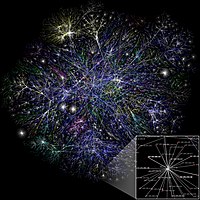
Photo from wikipedia
In recent years, the performance of the deep-learning-based object detection models for remote-sensing images (RSIs) improves with the increase of the hyperparameter scale. However, the state-of-the-art detection models are generally… Click to show full abstract
In recent years, the performance of the deep-learning-based object detection models for remote-sensing images (RSIs) improves with the increase of the hyperparameter scale. However, the state-of-the-art detection models are generally too cumbersome to adapt to the resource-constrained satellite platforms, and even general lightweight detection models cannot satisfy performance requirements. To solve those problems, a lightweight and accurately oriented object detection network for satellite on-orbit computing (SOCDet) is proposed from three levels. At the computing unit level, we propose an efficient computing unit Single-kernel Omni-dimensional Dynamic Convolution (SODC) to make SOCDet feature extraction more efficient. At the network module level, we design a structural reparameterization block (SRB) based on composite structure reparameterization to improve inference accuracy. A guided attention module (GAM) for guiding SOCDet is designed to extract object features. We design a lightweight and concise one-stage detection architecture at the network architecture level to accommodate satellite platforms with extremely constrained computing and storage resources. We conduct ablation experiments on the ground server and compare experiments with the state-of-the-art methods on embedded GPU, using DOTA, HRSC2016, and FAIR1M. The experimental results show that SOCDet can achieve $2.36\times $ faster than the baseline in inference speed with 10.78 more mAP, 72.6% fewer Params, and 92.56% fewer floating-point operations (FLOPs). Compared with state-of-the-art methods, SOCDet improves the inference speed and derives competitive mAP results with affordable computing capability.
Journal Title: IEEE Transactions on Geoscience and Remote Sensing
Year Published: 2023
Link to full text (if available)
Share on Social Media: Sign Up to like & get
recommendations!